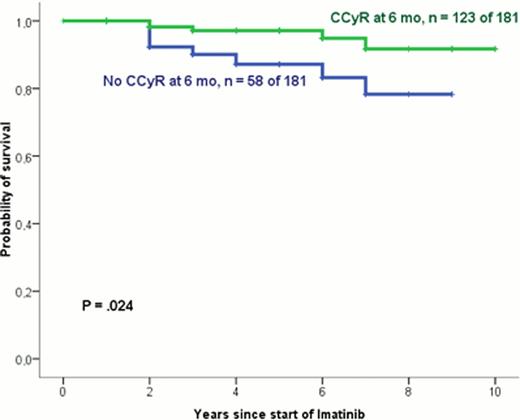Abstract
Abstract 4453
Treatment of chronic myeloid leukemia with imatinib leads to disease remission in a majority of patient, but in some patients (pts) controlling the disease remains a challenge. One of the proposed prognostic factors for identifying this subset of pts is the treatment response in the first months of therapy.
We conducted a study to evaluate the importance of the early complete cytogenetic response (CCyR) and the factors associated with its achievement.
This is a retrospective study in a cohort of pts with chronic-phase chronic myeloid leukemia (CP-CML) enrolled in 3 Hematology centers in South Brazil. All pts received imatinib 400mg as first or second-line therapy. Early-imatinib treatment was considered when imatinib started before 12 months (mo) from diagnosis. Patient evaluation and response criteria followed the ELN recommendations. The ACE-27 (Adult Comorbidity Evaluation-27) is a 27 item comorbidity index for patients with cancer and assign weights from 1 to 3 based on the dysfunction grade of each condition (mild, moderate and severe, respectively). An ACE-27 score was applied to each patient. Imatinib suspensions were considered if superior to 20 days at any point during therapy. Global survival (GS) was measured from the start of imatinib to the date of death from any cause.
We analyzed data from 181 pts with CP-CML diagnosed since 1990. The median age at diagnosis was 48 yr (4 – 85) and 55% were male. The median time from diagnosis to imatinib was 7 mo (0 – 178) and 71% pts were early-imatinib treated. Prior therapy with interferon was used in 60% pts. The median of follow-up was 47 mo. With 6 months of imatinib therapy, 123 pts (68%) achieved CCyR, in this group the four year global survival was 97%. 58 (32%) were not in CCyR at 6 months of therapy, in this group the four year GS was 87%. This difference was significant (P=.024; Figure 1). The chance of achieving major molecular response (MMR) during follow up was 79% for the pts with CCyR at 6 months compared to 53% for the group with no CCyR at 6 months (P<0,001). Some factors were associated with reduced chance of CCyR at 6 months. In a multivariate analysis, the pts with late-onset imatinib treatment (more than 12 mo from diagnosis) had a CCyR rate of 31%, in contrast, the pts who started imatinib before 12 mo had a rate of 50% (P=0,02). The pts with good adherence to treatment had greater CCyR rate than those with poor adherence (interruption greater than 20 days), 51,4% and 35%, respectively (P=0,04). Comorbidity measured by ACE-27 score also influenced the CCyR rates at 6 months: 54% of score 0 (no comorbidity) patients achieved CCyR, compared to 30% of pts with score 1 (mild comorbidity), 33% of pts with score 2 (moderate) and 47% of pts with score 3 (severe) (P=0,009). The greater CCyR rate in the severe comorbidity group probably lacks significance due to the reduced number of pts in this group (22).
A great proportion of pts achieve CCyR after 6 months of imatinib therapy, nevertheless, the pts who achieve CCyR by 6 months of therapy have greater proportion of major molecular response and global survival. Imatinib therapy should be started as soon as possible and additional efforts must be taken to avoid nonadherence. Finally, special attention should be given to pts with comorbidities as their results tend to be worse.
Global survival and complete cytogenetic response at 6 months of therapy in 181 CP-CML patients.
Global survival and complete cytogenetic response at 6 months of therapy in 181 CP-CML patients.
No relevant conflicts of interest to declare.
Author notes
Asterisk with author names denotes non-ASH members.


This feature is available to Subscribers Only
Sign In or Create an Account Close Modal